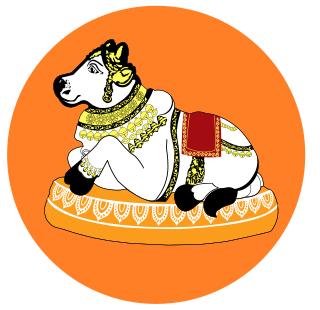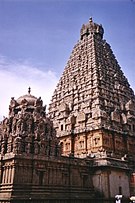
The Ramayana, also known as Valmiki Ramayana, as traditionally attributed to Valmiki, is a smriti text from ancient India, one of the two important epics of Hinduism known as the Itihasas, the other being the Mahabharata. The epic narrates the life of Rama, the seventh avatar of the Hindu deity Vishnu, who is a prince of Ayodhya in the kingdom of Kosala. The epic follows his fourteen-year exile to the forest urged by his father King Dasharatha, on the request of Rama's stepmother Kaikeyi; his travels across the forests in the Indian subcontinent with his wife Sita and brother Lakshmana; the kidnapping of Sita by Ravana, the king of Lanka, that resulted in bloodbath; and Rama's eventual return to Ayodhya along with Sita to be crowned as a king amidst jubilation and celebration.

A yogi is a practitioner of Yoga, including a sannyasin or practitioner of meditation in Indian religions. The feminine form, sometimes used in English, is yogini.

Mahasiddha is a term for someone who embodies and cultivates the "siddhi of perfection". A siddha is an individual who, through the practice of sādhanā, attains the realization of siddhis, psychic and spiritual abilities and powers.

The Siddhar in Tamil tradition is a perfected individual who has attained spiritual powers called siddhi.

Natha, also called Nath, are a Shaiva sub-tradition within Hinduism in India and Nepal. A medieval movement, it combined ideas from Buddhism, Shaivism and Yoga traditions of the Indian subcontinent. The Naths have been a confederation of devotees who consider Shiva as their first lord or guru, with varying lists of additional gurus. Of these, the 9th or 10th century Matsyendranatha and the ideas and organization mainly developed by Gorakhnath are particularly important. Gorakhnath is considered the originator of the Nath Panth.
According to various Indian schools of philosophy, tattvas are the elements or aspects of reality that constitute human experience. In some traditions, they are conceived as an aspect of the Indian deities. Although the number of tattvas varies depending on the philosophical school, together they are thought to form the basis of all our experience. The Samkhya philosophy uses a system of 25 tattvas, while Shaivism uses a system of 36 tattvas. In Buddhism, the equivalent is the list of Abhidharma which constitute reality, as in Namarupa.
In Jainism, godliness is said to be the inherent quality of every soul. This quality, however, is subdued by the soul's association with karmic matter. All souls who have achieved the natural state of unlimited bliss, unlimited knowledge, unlimited power and unlimited perception are regarded as God in Jainism. Jainism rejects the idea of a creator deity responsible for the manifestation, creation, or maintenance of this universe. Instead, souls who have reached Heaven for their merits and deeds influence the Universe for a fixed period until they undergo reincarnation and continue the cycle of enlightenment. According to Jain doctrine, the universe and its constituents have always existed. All constituents and actions are governed by universal natural laws and "perfect soul".

Gorakhnath was a Hindu yogi, mahasiddha and saint who was the founder of the Nath Hindu monastic movement in India. He is considered one of the two disciples of Matsyendranath. His followers are known as Jogi, Gorakhnathi, Darshani or Kanphata.
Jain cosmology is the description of the shape and functioning of the Universe (loka) and its constituents according to Jainism. Jain cosmology considers the universe as an uncreated entity that has existed since infinity with neither beginning nor end. Jain texts describe the shape of the universe as similar to a man standing with legs apart and arms resting on his waist. This Universe, according to Jainism, is broad at the top, narrow at the middle and once again becomes broad at the bottom.

Vasishta Yoga Samhita is a historically popular and influential syncretic philosophical text of Hinduism, dated to the 6th CE or 7th CE — 14th CE or 15th CE.

Jain symbols are symbols based on the Jain philosophy.
According to Jain doctrine, the universe and its constituents—soul, matter, space, time, and principles of motion—have always existed. Jainism does not support belief in a creator deity. All the constituents and actions are governed by universal natural laws. It is not possible to create matter out of nothing and hence the sum total of matter in the universe remains the same. Jain texts claim that the universe consists of jiva and ajiva. The soul of each living being is unique and uncreated and has existed during beginningless time.[a]

Acharya Pujyapada or Pūjyapāda was a renowned grammarian and acharya belonging to the Digambara tradition of Jains. It was believed that he was worshiped by demigods on the account of his vast scholarship and deep piety, and thus, he was named Pujyapada. He was said to be the guru of King Durvinita of the Western Ganga dynasty.

Sanskrit moksha or Prakrit mokkha refers to the liberation or salvation of a soul from saṃsāra, the cycle of birth and death. It is a blissful state of existence of a soul, attained after the destruction of all karmic bonds. A liberated soul is said to have attained its true and pristine nature of Unlimited bliss, Unlimited knowledge and Unlimited perception. Such a soul is called siddha and is revered in Jainism.
Jainism emphasises that ratnatraya — the right faith, right knowledge and right conduct — constitutes the path to liberation. These are known as the triple gems of Jainism and hence also known as Ratnatraya

Arihant is a jiva (soul) who has conquered inner passions such as attachment, anger, pride and greed. Having destroyed four inimical karmas, they realize pure self. Arihants are also called kevalins as they possess kevala jnana. An arihant is also called a jina ("victor"). At the end of their life, arihants destroy remaining karmas and attain moksha (liberation) and become siddhas. Arihantas have a body while siddhas are bodiless pure spirit. The Ṇamōkāra mantra, the fundamental prayer dedicated to Pañca-Parameṣṭhi, begins with Ṇamō arihantāṇaṁ, "obeisance to the arihants".

Debjan is a Bengali novel written by Bibhutibhushan Bandyopadhyay. The work is a fiction and deals with life after death. The name Debjan is derived from the Sanskrit word "Devyaan" which literally translated as the path of Gods. This is the path of no return, i.e. a soul traversing this path will be liberated according to the ancient Indian scriptures. The description of this path occurs in Upanishads and also in Gita. The other path is known as Pitr Yaan. A soul traversing this path will have to return to the world again for reaping the fruits of Karma. Gita refers to these two paths as the "White" and the "Black" paths, one which leads to eternal life and the other compels one to return to the world. The exact sloka, however does not take the name "Devyaan".

Ananta, is a Sanskrit term, and primarily an epithet of Vishnu.

The Paramahansa Upanishad, is one of the 108 Upanishadic Hindu scriptures, written in Sanskrit and is one of the 31 Upanishads attached to the Atharvaveda. It is classified as one of the Sannyasa Upanishads. According to Ramanujacharya, Paramhansa is one of the forms of Lord Vishnu who imparted vedas to Lord Brahma in the form of Divine Swan as per Vishnu-Sahasranama.
Ākāśa is space in the Jain conception of the cosmos. It is one of the six dravyas (substances) and it accommodates the other five, namely sentient beings or souls (jīva), non-sentient substance or matter (pudgala), principle of motion (dharma), the principle of rest (adharma) and time (kāla)



















